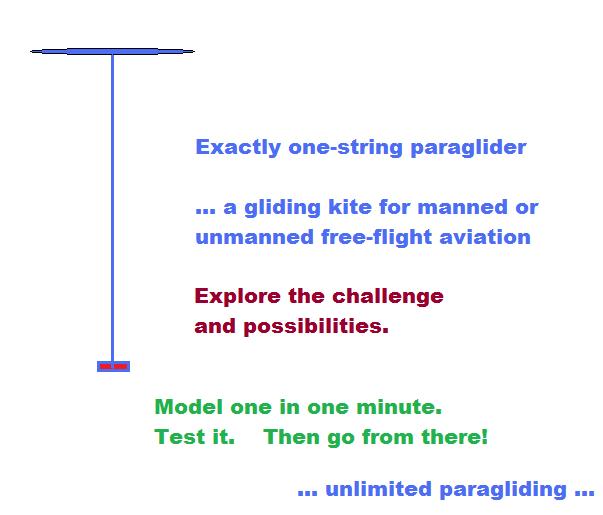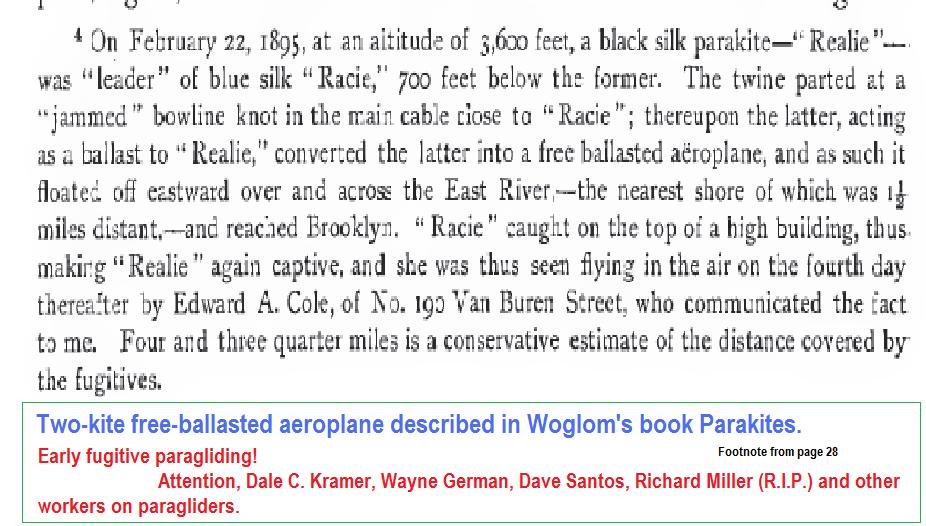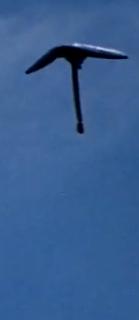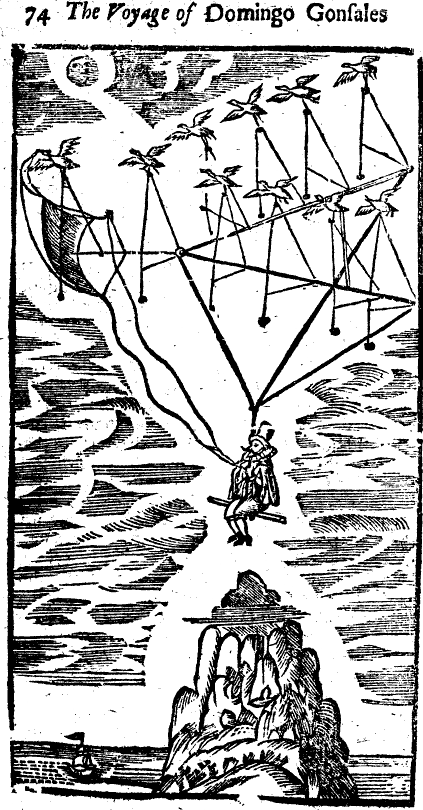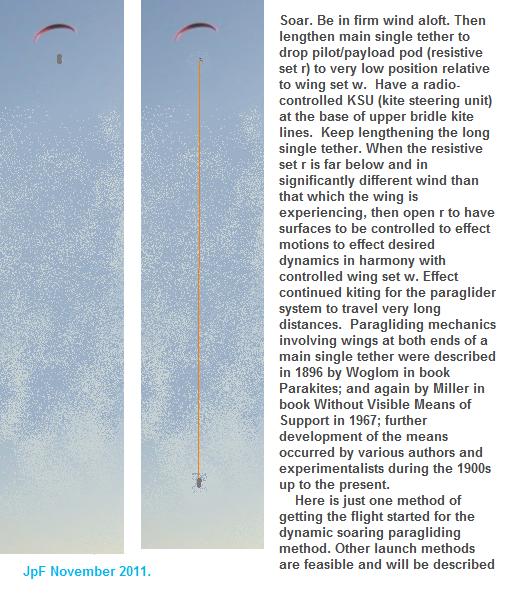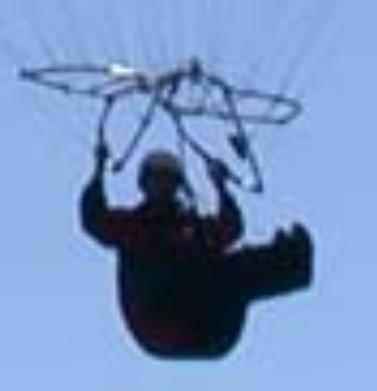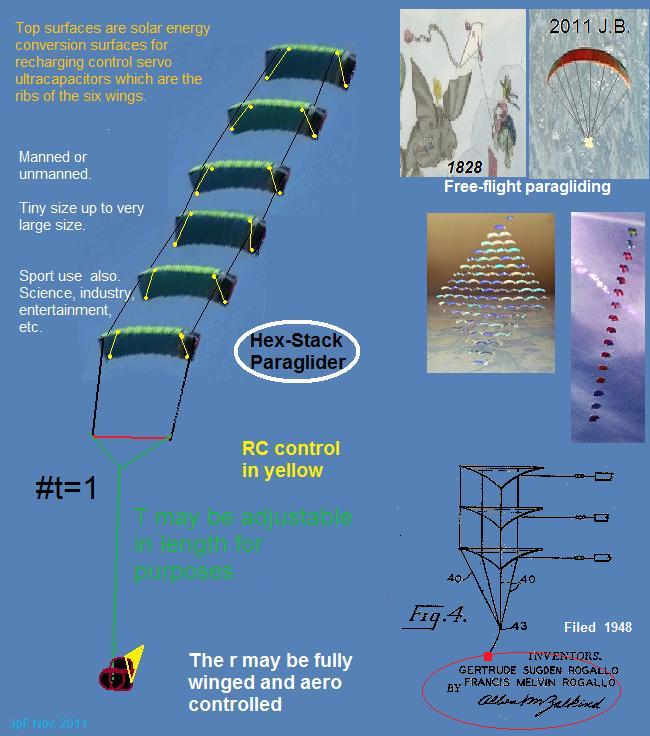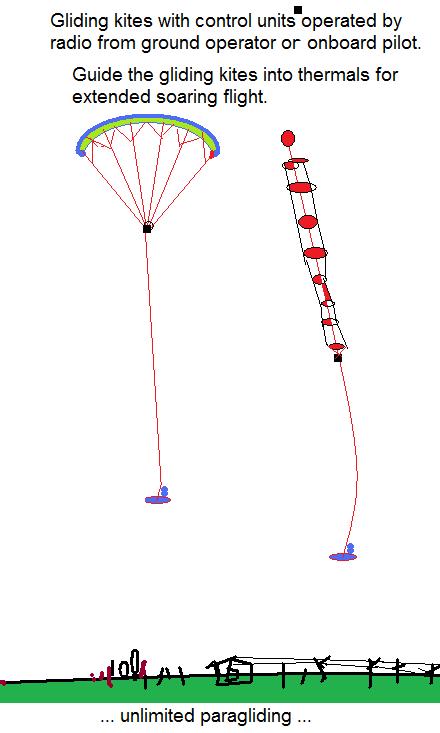What we need to take into account is Joe's attempt at renaming
everything.
Rod, not renaming, but naming by mechanical generics; the items are
not new; if you are unfamiliar with a paraglider being generically
mechanically a gliding kite, then some disorientation might occur for
you for some time. And your use of "everything" is far too wide,
Rod; such is not the case. Just a couple of terms recognizing
mechanical history, not a renaming.
He
has, in the past, referred to paragliders as kites, paragliders as
hang gliders, hang gliders as paragliders, and just about everything
as gliding kites.
Rod, care is to be taken on the third item in
your mentioned series, as not all hang gliders are paragliders; e.g.
when no tether is involved inthe hang glider, then kite hang glider
cannot be, and thus paraglider cannot be. The short-single-tethered
Falcon 3 by Wills Wing is a paraglider as it is a gliding kite; but
Otto Lilienthal gliders where hang gliders that were not paraglider
hang gliders, as he placed his body directly on the airframe to let
gravity do its powering. And your exuberance goes too far;
do you overstate like that just to hit? Things are
simpler: gliding kite is paraglider (type of hang glider), but there
are hang gliders that are not paragliders.
Quote: "single short-tether gliding kite paraglider" = hang glider
Yes.
Quote: "multi-long-tethered hang gliders" = paraglider
Yes, when
in gliding flight, we are presuming.
And now we can add: "single f...-long-tethered paraglider" = brainless
kite idea
Rod, you dance on the grave of Woglom, Miller, and on the living
legend of Wayne German and Dave Santos, and on patent applicant
soaring champion Dale C. Kramer. To achieve what is feasible at
various scales in this matter of gliding-kite (paraglider) is taking
considerable brain investment by many workers. You are
invited to apply your brain on this paraglider matter. Explore perhaps
how much aerodynamics can be applied to the set r where itself
may be a wing set. And notice that control centers may be in r or in t
or in w or in all three sets or two of them in combination, or from
some remote RC ground or aircraft point; the controls passive or
active will affect the aerodynamics of the elements in r and the
elements in w. The single line in t will be made visible
to other aircraft by one or several means.
So, now armed with the correct tools for the job, we can do a little
translation to get at the core of Joe's last message [with minimal
editorial guidance]:
|
Quote: |
Happy  to
predict that a very long single-tethered paraglider will set
extreme world records for cross-country travel with humans aboard. to
predict that a very long single-tethered paraglider will set
extreme world records for cross-country travel with humans aboard. |
I'm happy  to
predict that a kite with a very long line will set world records for
cross-country travel with people aboard. to
predict that a kite with a very long line will set world records for
cross-country travel with people aboard.
Rod, the slippery translation is technically correct, but in context
it would be stronger for readers to have emphaszed that the kite is of
a sort that the r of the kite is moving in the air stream in
fall mode and in a manner that the r is part of the full gliding
resultant. Some of your readers will have a habit over "kite" as
being with r set soiled only, which is much too limiting. The
"kite" involved is a gliding sort with its integrity moving along the
air stream and not soiled.
|
Quote: |
|
Controls of the unpowered paraglider will effect attitudes in the
upper wing and attitudes in the lower resistive subassembly. |
The kite will be controlled from below. [Great idea!]
Rod, as noted above in confirmation, the gliding kite (paraglider)
could be controlled from above at w, from t above r, from r, from both
w and t, from both w and r, from t and r, for from remote RC control
from ground stations or other aircraft or combinations of the noted
placements of control. The challenge is not limited to "below."
|
Quote: |
|
Dale C. Kramer has for years been mapping out flights using
detailed weather reports. |
Dale C. Kramer has been planning flights using detailed weather
reports for years. [Wow!]
Rod, his Lazair success is part of his pattern; his soaring wins are
part of his pattern; his professional services to soaring are part of
his pattern. His sharing his paraglider trans-continental planning has
been a careful intensive work; he shared long-flight simulations and
planning at our AWE 2009 HAWP conference in Chico, California. I
introduced him to Richard Miller's earlier work on topic and the
contemporary work by Wayne German, Dave Santos, and myself.
Tracking the wind strata and planning the flights is no simple matter;
the long tether and the positions of r and w and the needed controls
form a strong challenge for engineering. Launching
methods are being studied. Risk management is no small matter. We do
not want to drag r across highways, buildings, powerlines.
Unmanned version of 1895 had some success, but we are reaching for
fully controlled trans-continental paraglider flights with humans
aboard; humans may be in r or in w or midway in t or in two of those
or in all three of those placements. And we are studying if the team
aboard should be more for shift work or whether controls will be
strong enough to allow sleep and alerting systems to suffice.
The kite will have no motor.
Rod, again it might be better to help the reader know that the "kite"
is of the sort "gliding kite" in free-flight mode without soil contact
during the flight. It is also key to note that there would
be no fuel for lift, but that is not the same as your translation.
There may be energy-gathering from the flight and that energy may be
used to perform controls, performed obstacle lighting, perform
communications, perform warming, etc, but not lift. Lift will come
from r and w using dynamics of the winds alone. There may be
motors for control, but not to propel for getting lift. The result
would not be a powered paraglider, but just a paraglider. You
personally have exercised your muscles to effect control on the lines
to alter w in your gliding kite (paraglider); you are the control
motor in such case.
|
Quote: |
|
This is a proud future for machine paraglider. |
One giant leap for mankind, one small step for kites. [and one f...
long string]
Yes and no and yes. Mankind has not yet achieved heavier-than-air
paraglider flight of humans across a continent in one flight session;
this will be no small step for kites (of the sort: gliding kites with
humans aboard). And yes, the string will be long in order to
utilize wind strata differences. The demonstration will usher in a New
Aviation option where goods and people will be able to travel without
fuel for very long distances. Though unmanned feasibility
demonstrations have occurred, the stark human travel in such a
paraglider is yet to be achieved; balance of parameters is needed, not
new science. Craft, testing, daring ... are needed. We were hoping a
free flying duck might be part of the flight crew.
|
Quote: |
|
Clearance for the record flights will be specially given by
airspace governance, as the long line will be obstacle and the
airspace used will be that which is frequented by commercial
aircraft. |
The kite will be filing an air plan.
Yes, that will be needed; other aircraft will
be affected during a major effort; resistance from the businesses that
run other aircraft will be significant; perhaps we can include them in
some advertising deal to help get the flight plan permitted; we are
considering carrying logos in the paraglider and in news references
concerning the project. If the effort becomes a matter of
national pride, then major players might help it all happen over their
respective continents. One flight over
Australia, over Africa central, over Europe, over Asia ...
best paths and times are being studied. Records will
be set; some first flights might be short; perhaps a starting point is
one calculated by Kramer: just officially beat the sailplane distance
record. Then go from there with more robust efforts.
|
Quote: |
|
As the physics allow cross-continent paraglider flight, it will be
permitted at least once. |
The kite will be allowed access to controlled airspace.
Rod, again the translation could be sharpened for project purpose:
"the paraglider (a gliding kite) will be allowed to use controlled
airspace." Your readers might be keeping their feet
soiled; consider helping the project by seeing the paraglider aspect
where mechanically there is the gliding kite unsoiled during the
flight.
|
Quote: |
|
Moderator Team: May
I attach drawings and documents illustrating these matters? |
I
have been such an unscrupulous git in the past, by changing website
images in forum conversations, that I am no longer allowed to post
links to external images. However, my grasp on all thing technical is
so limited that I have failed to realise I can still upload images to
the forum as they will be uneditable. [I'm just guessing this one!]
Rod, the Moderators are apparently not allowing me to show drawings; I
am asking directly for permission as I do want to keep peace with the
Moderator Team. I asked specifically about several ways to show
images; the Team did not answer to the specific methods wondered
about; they just put a general command; the matter is still fuzzy;
others are allowed external image calls and video. Rod, I
am in the habit of updating images to express progress or accuracy. I
did not appreciate that someone would be disturbed by one editing
one's own graphics; but the Moderator Team might have a challenge with
such; so I await direct permission to either upload images to the
forum server or to images in my server; I asked directly for
clarification and only received back a dictum that has me wait for
direct permission now.
Executive summary: he predicts that in the future we will see a kite
flying very high with a long line and people hanging under it.
Rod, it is that a gliding kite will be used, that is, a paraglider.
Executive conclusion: there are wealthy Americans willing to have a
lash at anything just to get in the record books.
There are also others in other nations willing to set records; the
cross-continent paraglider one-session flight is open to any person on
earth; interest has been shown from many nations already; some
coordination is occurring through the
AWEIA.
Some notes are on:
HERE.
(the other)
Rod B |
